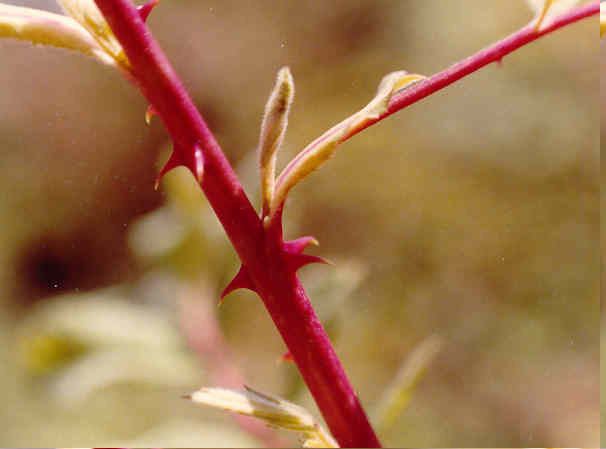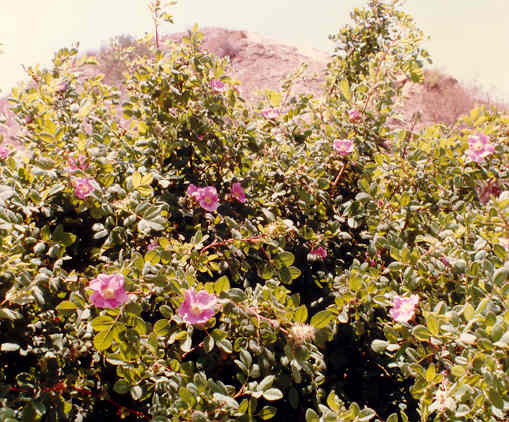
Rosa californica Cham. & Schldl.
 |
Rosa californica Cham. & Schldl.
Rosaceae (Rose Family)NativeCalifornia Wild Rose |
April Photo
Plant Characteristics:
Erect, shrub, branched, 1-3 m. tall, armed with stout flattened usually
recurved prickles; petiole and rachis pubescent, prickly, non-glandular to
glandular; lfts. 5-7, oval 1-3.5 cm. long, simply or double serrate, puberulent
above, pubescent and often glandular beneath, terminal leaflet generally 15-60
mm., +/- elliptic, tip +/- obtuse margins single or double toothed, glandular or
not; stipules narrow; infl.
1-20 fld., corymbose; pedicels glabrous to villous, sometimes glandular, usually
less than 2 cm. long; fl.-tube glabrous or pilose when young; sepals lanceolate,
persistent in fr., caudate-attenuate, sometimes glandular; petals 1-2.5 cm.
long; fr. globose to ovoid, 8-16 mm. long, 10-15 mm. thick, usually with
distinct neck.
Habitat:
Fairly moist places, canyons, near streams, etc., below 6000 ft.; many
Plant Communities; cismontane; n. L. Calif. to s. Ore.
May-Aug. Variable.
Name:
Rosa is an ancient Latin name whose exact meaning has been lost in
the mists of time. Californica indicates that the plant was first
described from specimens that came from this state.
(Dale 13,173).
General:
Rare, in the study area. The
only specimen that I found for several years was at the mouth of a gully along
the path from 23rd St. to the Delhi Ditch.
The one specimen stood six or more feet high and was apparently very old
as the limbs at the base of the plant were quite thick.
The plant was destroyed when the Irvine Co. graded the steep sided gully
and installed erosion control materials, which mostly washed out the next year.
The root of the plant was covered with several feet of soil; however,
there were a few shoots that tried to establish themselves either from the root
or from seeds but none of these survived. In
about 1992, the Dept. of Fish and Game planted of number of native plants in Big
Canyon; one of these was Rosa californica.
This plant did not bloom until 1996 when identification was finally
possible. In 1998, I found two more small plants in the flat area below the
intersection of Back Bay Dr. and Eastbluff Dr. (my comments).
The hip is said to contain more vitamin C, calcium, phosphorus and iron
than oranges. Hips can be dried for
tea or used for jelly. The dry
inner seeds must be removed. The
flowers have long been used in folk recipes for butter, perfume, candy, jelly
and tea. The Cahuillas, Indians of
the Colorado Desert, the San Jacinto and San Bernardino Mountains, picked the
buds and ate them raw or soaked the blossoms in water to make a drink.
Some tribes made a tea from the roots for colds and from the leaves and
fruits for pains and colic. The
young wood was used for arrow shafts and the fibre from the bark was used in
making twine and other goods. The
rose thickets provide good shelter and nesting sites.
The Audubon Cottontail and the wood rat are among those western animals
utilizing the rose. (Clarke 81). No Calif. wildflower gave greater
pleasure to the pioneering Spaniards of 200 years ago than did the Wild Rose. The diaries of the Franciscan padres contain many references
to it, as it reminded them affectionately of the sweet roses of Spain, they called it the Rose of
Castile. (Dale 173).
Rose hips stay on the plant for a year and can be gathered for food in
the winter. (lecture by Charlotte
Clarke, author of Useful and Edible Plants of California, April 1987).
Rosa species have been known to cause hay fever and asthma.
(Fuller 381). The wild rose is one of the few
flowers that blooms cheerfully through the long summer days, lavishing its
beautiful clusters of deliciously fragrant flowers as freely along the dusty
roadside and in the more secluded thicket.
(Parsons 240).
Delfina Cuero, a Kumeyaay or Southern Diegueno Indian, made the following
comments about wild roses in her autobiography:
"The wild rose was used as a medicine; gather flower petals or
leaves (if no flowers available); boil them and use the liquid to bathe eyes
when have a cold in the eyes. The
fruit and seed ground as food." (Shipek
96). A
good treatment for diarrhea; five to ten flowers or buds of Rosa spp.
steeped in hot water for twenty minutes and drunk as often as needed, generally
every two or three hours, beginning at least twelve hours after the onset.
(Moore, Medicinal Plants of the Mountain West 142).
Roses and all flowers containing perfumed oils, may be made to yield
their aromatic properties by steeping the petals or flower leaves in a saucer or
flat dish of water, and setting it in the sun.
The petals should be entirely covered with water, which should be soft or
rain water. A sufficient quantity
should be allowed for evaporation, and the vessel should be left undisturbed for
a few days. At the end of this time
a film will be found floating on the top. This
is the essential oil of the flower, and every particle of it is impregnated with
the odor peculiar to the flower. It
should be taken up carefully and put in tiny vials, which should remain open
until all water particles are evaporated. (Meyer
203). The
old straight wood was used for arrow shafts.
(Sweet 20).
Text Ref:
Hickman, Ed. 973; Munz, Flora So. Calif. 759; Robbins et al. 248.
Photo Ref:
Mar-April 84 # 21; May 1 84 # 24; May 3 84 # 2.
Identity: by R. De Ruff, confirmed by F. Roberts.
First Found: April 1984.
Computer Ref: Plant Data 268.
Have plant specimen.
Last edit 10/14/04
 |
 |
May Photo May Photo